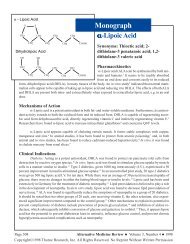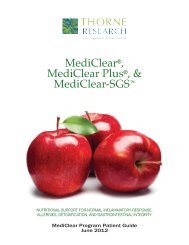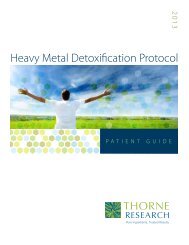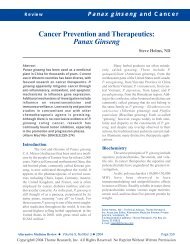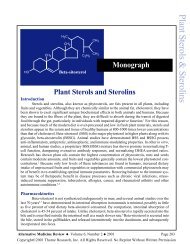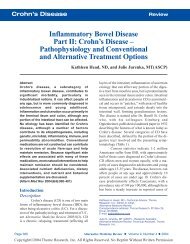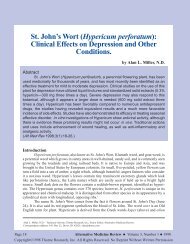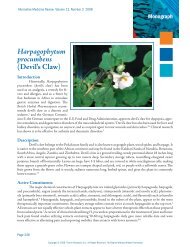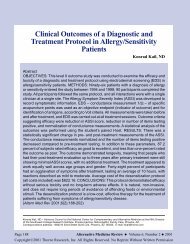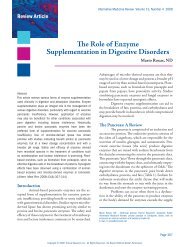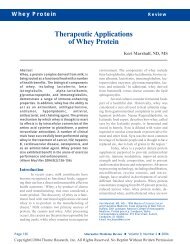Diosmin - Thorne Research
Diosmin - Thorne Research
Diosmin - Thorne Research
You also want an ePaper? Increase the reach of your titles
YUMPU automatically turns print PDFs into web optimized ePapers that Google loves.
<strong>Diosmin</strong>Monograph<strong>Diosmin</strong>OHHOOHOOOCH 3HOOOHO<strong>Diosmin</strong>ODescriptionHOO<strong>Diosmin</strong> is a naturally occurringflavonoid glycoside thatcan be isolated from various plantHOCH 3sources or derived from the flavonoidhesperidin. <strong>Diosmin</strong> wasOHfirst isolated in 1925 fromScrophularia nodosa, and first introducedas a therapeutic agent in1969. <strong>Diosmin</strong> is considered to be a vascular-protecting agent used to treat chronic venous insufficiency,hemorrhoids, lymphedema, and varicose veins. As a flavonoid, diosmin also exhibits anti-inflammatory,free-radical scavenging, and antimutagenic properties.<strong>Diosmin</strong> differs molecularly from hesperidin by the presence of a double bond between two carbonatoms in diosmin’s central carbon ring. <strong>Diosmin</strong> can be manufactured by extracting hesperidin from citrusrinds, followed by conversion of hesperidin to diosmin. <strong>Diosmin</strong> has been used for more than 30 years as aphlebotonic and vascular-protecting agent, and has recently begun to be investigated for other therapeuticpurposes, including cancer, premenstrual syndrome, colitis, and diabetes.Biochemistry and PharmacokineticsFlavonoids are a large group of plant pigments sharing the same basic chemical structure; i.e., athree-ringed molecule with hydroxyl (OH) groups attached. <strong>Diosmin</strong> (C 28H 32O 15) occurs naturally as a glycoside,meaning it has a sugar molecule attached to its three-ringed flavonoid structure.Pharmacokinetic investigations have shown diosmin is rapidly transformed by intestinal flora to itsaglycone form, diosmetin. Diosmetin is absorbed and rapidly distributed throughout the body with a plasmahalf-life of 26-43 hours. Diosmetin is degraded to phenolic acids or their glycine-conjugated derivativesand eliminated through the urine. <strong>Diosmin</strong> or diosmetin not absorbed is eliminated in the feces. 1,2Mechanisms of Action<strong>Diosmin</strong>’s mechanisms of action include improvement of venous tone, increased lymphatic drainage,protection of capillary bed microcirculation, inhibition of inflammatory reactions, and reduced capillarypermeability. 3-6 Certain flavonoids, including diosmin, are potent inhibitors of prostaglandin E2 (PGE2)and thromboxane A2 (TxA2) 7 as well as being inhibitors of leukocyte activation, migration, and adhesion.<strong>Diosmin</strong> causes a significant decrease in plasma levels of endothelial adhesion molecules and reducesneutrophil activation, thus providing protection against microcirculatory damage. 8,9Page 308 Alternative Medicine Review ◆ Volume 9, Number 3 ◆ 2004Copyright©2004 <strong>Thorne</strong> <strong>Research</strong>, Inc. All Rights Reserved. No Reprint Without Written Permission
Monograph<strong>Diosmin</strong>Clinical IndicationsVaricose Veins/Chronic VenousInsufficiencyChronic venous insufficiency is characterizedby pain, leg heaviness, a sensation of swelling,and cramps, and is correlated with varicoseveins. A multicenter international trial, carried outin 23 countries over two years, in which 5,052symptomatic patients were enrolled, evaluated theefficacy of flavonoids in the treatment of chronicvenous insufficiency. Patients were treated with450 mg diosmin and 50 mg hesperidin daily forsix months. Continuous clinical improvement wasfound throughout the study, as well as improvementsin quality of life scores for participants. 10<strong>Diosmin</strong>-containing flavonoid mixtureshave also been effective in treating severe stagesof chronic venous insufficiency, including venousulceration and delayed healing. 3,5 In a randomizedmulticenter trial, 900 mg diosmin and 100 mghesperidin plus standard venous ulcer managementwas compared with standard venous ulcer managementalone. Standard ulcer management includedcleaning, compression therapy, and skincare of the adjacent skin. Forty-seven percent ofpatients in the treatment group compared to 28percent in the standard management group experiencedcomplete healing of ulcers less than 10cm in diameter. 11HemorrhoidsSeveral large clinical trials have demonstrateddiosmin to be effective in the treatment ofacute and chronic symptoms of hemorrhoids. Adouble-blind, placebo-controlled study of 120patients showed improvement of pain, pruritis,discharge, edema, erythema, and bleeding on examination.12 The treatment group was given a flavonoidmixture (90% diosmin and 10% hesperidin)at a dose of two 500-mg tablets daily for twomonths.The use of diosmin in the treatment ofhemorrhoids associated with pregnancy did notadversely affect pregnancy, fetal development,birth weight, infant growth, or infant feeding. Pregnantwomen suffering from acute hemorrhoidswere treated eight weeks before delivery and fourweeks after delivery. More than half of the womenparticipating in the study reported relief fromsymptoms by the fourth day. 13 <strong>Diosmin</strong> is nonmutagenicand does not have any significant effecton reproductive function. 14Lymphedema<strong>Diosmin</strong> acts on the lymphatic system byincreasing lymph flow and lymph oncotic pressure.15,16 A flavonoid mixture containing diosminwas used to treat upper limb lymphedema secondaryto conventional therapy for breast cancer. Resultsshowed improvement of symptoms and limbvolume; the mean decrease in volume of the swollenlimb reached 6.8 percent. 16 In addition, lymphaticfunctional parameters assessed with scintigraphywere significantly improved. Animalstudies of high-protein lymphedema, such as inburns and lung contusions, showed significantimprovement with diosmin. 17Diabetes<strong>Diosmin</strong> has been shown to improve factorsassociated with diabetic complications. Bloodparameters of glycation and oxidative stress weremeasured in type 1 diabetic patients before andafter intervention with a diosmin-containing flavonoidmixture. A decrease in hemoglobin A1cwas accompanied by an increase in glutathioneperoxidase, 18 demonstrating long-term decreasedblood glucose levels and increased antioxidantactivity.<strong>Diosmin</strong> can normalize capillary filtrationrate and prevent ischemia in diabetics. Rheologicalstudies of type 1 diabetics show diosmin canfacilitate hemorheological improvements due todecreased RBC aggregation, which decreasesblood flow resistance, resulting in reduction ofboth stasis and ischemia. 19-21Cancer<strong>Diosmin</strong> has been investigated in a numberof animal models and human cancer cell lines,and has been found to be chemopreventive andantiproliferative. 22-26 More clinically oriented researchin this area is warranted to determine effectivedosages and protocols.Alternative Medicine Review ◆ Volume 9, Number 3 ◆ 2004 Page 309Copyright©2004 <strong>Thorne</strong> <strong>Research</strong>, Inc. All Rights Reserved. No Reprint Without Written Permission
<strong>Diosmin</strong>MonographOther Clinical IndicationsStudies have also investigated the use ofdiosmin for stasis dermatitis, 3 wound healing, 27premenstrual syndrome, 28 mastodynia, 29,30dermatofibrosclerosis, 3 viral infections, 31 and colitis.32 More clinically oriented research is indicated.Drug-Nutrient Interactions<strong>Diosmin</strong> can cause a decrease in RBCaggregation and blood viscosity. 19 There are nodocumented cases of adverse interactions betweendiosmin and prescription medications, but cautionshould be taken when combining diosmin withaspirin or other blood-thinning medications.Data suggest that diosmin has an inhibitoryeffect on cytochrome P450-mediated metabolismin healthy volunteers, which may alter thepharmacokinetics of drugs taken concomitantly.Patients given metronidazole after nine days ofpretreatment with 450 mg diosmin demonstratedchanges in serum concentrations of metronidazole,as well as changes in urinary concentrations ofmetronidazole and its metabolites compared tocontrols. 33Side Effects and ToxicityIn animal studies, a flavonoid mixturecontaining 90-percent diosmin and 10-percenthesperidin had an LD 50of more than 3g/kg. Inaddition, animal studies have shown the absenceof acute, subacute, or chronic toxicity after repeatedoral dosing for 13 and 26 weeks using adose representing 35 times the recommended dailydose. 14<strong>Diosmin</strong> is considered to have no mutagenicactivity, embryo toxicity, nor any significanteffect on reproductive function. Transplacentalmigration and passage into breast milk are minimal.14DosageThe standard dose of diosmin is 500 mgtwice daily. For acute dosing, a loading dose of1,000 mg three times daily for four days is recommended,followed by 1,000 mg twice daily forthree days, and a maintenance dose of 500 mgtwice daily for two months.References1. Cova D, De Angelis L, Giavarini F, et al.Pharmacokinetics and metabolism of oraldiosmin in healthy volunteers. Int J ClinPharmacol Ther Toxicol 1992;30:29-33.2. Lyseng-Williamson KA, Perry CM.Micronised purified flavonoid fraction: areview of its use in chronic venous insufficiency,venous ulcers and haemorrhoids.Drugs 2003;63:71-100.3. Ramelet AA. Clinical benefits of Daflon 500mg in the most severe stages of chronic venousinsufficiency. Angiology 2001;52:S49-S56.4. Smith PD. Neutrophil activation and mediatorsof inflammation in chronic venous insufficiency.J Vasc Res 1999;36:24-36.5. Bergan JJ, Schmid-Schonbein GW, Takase S.Therapeutic approach to chronic venousinsufficiency and its complications: place ofDaflon 500 mg. Angiology 2001;52:S43-S47.6. Le Devehat C, Khodabandehlou T, Vimeux M,Kempf C. Evaluation of haemorheological andmicrocirculatory disturbances in chronicvenous insufficiency: activity of Daflon 500mg. Int J Microcirc Clin Exp 1997;17:27-33.7. Labrid C. Pharmacologic properties of Daflon500 mg. Angiology 1994;45:524-530.8. Ramelet AA. Pharmacologic aspects of aphlebotropic drug in CVI-associated edema.Angiology 2000;51:19-23.9. Manthey JA. Biological properties of flavonoidspertaining to inflammation. Microcirculation2000;7:S29-S34.10. Jantet G. Chronic venous insufficiency:worldwide results of the RELIEF study. Refluxassessment and quality of life improvementwith micronized flavonoids. Angiology2002;53:245-256.11. Glinski W, Chodynicka B, Roszkiewicz J, etal. The beneficial augmentative effect ofmicronised purified flavonoid fraction (MPFF)on the healing of leg ulcers: an open,multicenter, controlled, randomized study.Phlebology 1999;14:151-157.12. Godeberge P. Daflon 500 mg in the treatmentof hemorrhoidal disease: a demonstratedefficacy in comparison with placebo. Angiology1994;45:574-578.13. Buckshee K, Takkar D, Aggarwal N. Micronizedflavonoid therapy in internal hemorrhoidsof pregnancy. Int J Gynaecol Obstet1997;57:145-151.Page 310 Alternative Medicine Review ◆ Volume 9, Number 3 ◆ 2004Copyright©2004 <strong>Thorne</strong> <strong>Research</strong>, Inc. All Rights Reserved. No Reprint Without Written Permission
Monograph<strong>Diosmin</strong>14. Meyer OC. Safety and security of Daflon 500mg in venous insufficiency and in hemorrhoidaldisease. Angiology 1994;45:579-584.15. Pecking AP, Fevrier B, Wargon C, Pillion G.Efficacy of Daflon 500 mg in the treatment oflymphedema (secondary to conventionaltherapy of breast cancer). Angiology1997;48:93-98.16. Pecking AP. Evaluation by lymphoscintigraphyof the effect of a micronized flavonoid fraction(Daflon 500 mg) in the treatment of upperlimb lymphedema. Int Angiology 1995;14:39-43.17. Casley-Smith JR, Casley-Smith JR. The effectsof diosmin (a benzo-pyrone) upon some highproteinoedemas: lung contusion, and burn andlymphoedema of rat legs. Agents Actions1985;17:14-20.18. Manuel Y, Keenoy B, Vertommen J, De LeeuwI. The effect of flavonoid treatment on theglycation and antioxidant status in type 1diabetic patients. Diabetes Nutr Metab1999;12:256-263.19. Lacombe C, Bucherer C, Lelievre JC.Hemorheological improvement after Daflon500 mg treatment in diabetes. Int Angiol1988;7:21-24.20. Lacombe C, Lelievre JC, Bucherer C,Grimaldi A. Activity of Daflon 500 mg on thehemorheological disorders in diabetes. IntAngiol 1989;8:45-48.21. Valensi PE, Behar A, de Champvallins MM, etal. Effects of a purified micronized flavonoidfraction on capillary filtration in diabeticpatients. Diabet Med 1996;13:882-888.22. Kuntz S, Wenzel U, Daniel H. Comparativeanalysis of the effects of flavonoids onproliferation, cytotoxicity, and apoptosis inhuman colon cancer cell lines. Eur J Nutr1999;38:133-142.23. Yang M, Tanaka T, Hirose Y, et al.Chemopreventive effects of diosmin andhesperidin on N-butyl-N-(4-hydroxybutyl)nitrosamine-induced urinary-bladder carcinogenesisin male ICR mice. Int J Cancer1997;73:19-24.24. Tanaka T, Makita H, Kawabata K, et al.Modulation of N-methyl-N-amylnitrosamineinducedrat oesophageal tumourigenesis bydietary feeding of diosmin and hesperidin,both alone and in combination. Carcinogenesis1997;18:761-769.25. Tanaka T, Makita H, Kawabata K, et al.Chemoprevention of azoxymethane-inducedrat colon carcinogenesis by the naturallyoccurring flavonoids, diosmin and hesperidin.Carcinogenesis 1997;18:957-965.26. Tanaka T, Makita H, Ohnishi M, et al.Chemoprevention of 4-nitroquinoline 1-oxideinducedoral carcinogenesis in rats by flavonoidsdiosmin and hesperidin, each aloneand in combination. Cancer Res 1997;57:246-252.27. Hasanoglu A, Ara C, Ozen S, et al. Efficacy ofmicronized flavonoid fraction in healing ofclean and infected wounds. Int J Angiol2001;10:41-44.28. Serfaty D, Magneron AC. Premenstrualsyndrome in France: epidemiology andtherapeutic effectiveness of 1000 mg ofmicronized purified flavonoid fraction in 1,473gynecological patients. Contracept Fertil Sex1997;25:85-90. [Article in French]29. Meggiorini ML, Cascialli GL, Luciani S, et al.Randomized study of the use of syntheticdiosmin in premenstrual and vascular dysplasticmastodynia. Minerva Ginecol 1990;42:421-425. [Article in Italian]30. Ciardetti P, Zucconi G, Ottanelli S, Casparis D.Treatment of mastodynia with syntheticdiosmin. Ann Ostet Ginecol Med Perinat1985;106:258-266. [Article in Italian]31. Bae EA, Han MJ, Lee M, Kim DH. In vitroinhibitory effect of some flavonoids onrotavirus infectivity. Biol Pharm Bull2000;23:1122-1124.32. Crespo ME, Galvez J, Cruz T, et al. Antiinflammatoryactivity of diosmin and hesperidinin rat colitis induced by TNBS. PlantaMed 1999;65:651-653.33. Rajnarayana K, Reddy MS, Krishna DR.<strong>Diosmin</strong> pretreatment affects bioavailability ofmetronidazole. Eur J Clin Pharmacol2003;58:803-807.Alternative Medicine Review ◆ Volume 9, Number 3 ◆ 2004 Page 311Copyright©2004 <strong>Thorne</strong> <strong>Research</strong>, Inc. All Rights Reserved. No Reprint Without Written Permission



